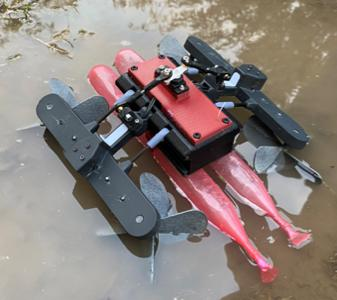Nov 3 2020
Inspired by the way lizards and cockroaches move, a new high-speed amphibious robot with the capability to swim and run on top of water at high speeds and crawl on tough landscape has been built by scientists from Ben-Gurion University of the Negev (BGU).
 A new high-speed amphibious robot inspired by the movements of cockroaches and lizards, developed by Ben-Gurion University of the Negev (BGU) researchers, swims and runs on top of water at high speeds and crawls on difficult terrain. Image credit: Ben-Gurion University
A new high-speed amphibious robot inspired by the movements of cockroaches and lizards, developed by Ben-Gurion University of the Negev (BGU) researchers, swims and runs on top of water at high speeds and crawls on difficult terrain. Image credit: Ben-Gurion University
The AmphiSTAR robot’s mechanical design and control system were exhibited virtually last week at the International Conference on Intelligent Robots and Systems (IROS) by Dr. David Zarrouk, director, Bioinspired and Medical Robotics Laboratory in BGU’s Department of Mechanical Engineering, and graduate student Avi Cohen.
The AmphiSTAR uses a sprawling mechanism inspired by cockroaches, and it is designed to run on water at high speeds like the basilisk lizard. We envision that AmphiSTAR can be used for agricultural, search and rescue and excavation applications, where both crawling and swimming are required.
Dr David Zarrouk, Director, Bioinspired and Medical Robotics Laboratory, Department of Mechanical Engineering, Ben-Gurion University of the Negev
The palm-size AmphiSTAR, part of the series of STAR robots created at the lab, is a wheeled robot equipped with four propellers under whose axes can be sloped using the sprawl mechanism. The propellers serve as wheels on the ground and as fins to drive the robot over water while running and swimming on water at high speeds of 1.5 m/second.
Two air tanks allow it to float and shift easily between high speeds when hovering on water to lower swimming speeds, and from swimming to crawling and vice versa.
The experimental robot is capable of crawling over grass, gravel, and concrete as fast as the original STAR robot and can reach speeds of 3.6 m/second (3.3 mph).
Our future research will focus on the scalability of the robot and on underwater swimming.
Dr David Zarrouk, Director, Bioinspired and Medical Robotics Laboratory, Department of Mechanical Engineering, Ben-Gurion University of the Negev
This research was funded partly by the BGU Helmsley Charitable Trust via the Agricultural, Biological and Cognitive Robotics Initiative, and by the Marcus Endowment Fund, both at Ben-Gurion University of the Negev.
The Marcus legacy gift, of more than $480 million, was donated to American Associates, Ben-Gurion University of the Negev in 2016 by Dr Howard and Lottie Marcus. The donation is the largest gift offered to any Israeli university and is said to be the largest gift to any institution in Israel.
Amphibious STAR is a high speed robot capable of crawling over land and hovering over water
A video of AmphiSTAR. Video credit: Ben-Gurion University